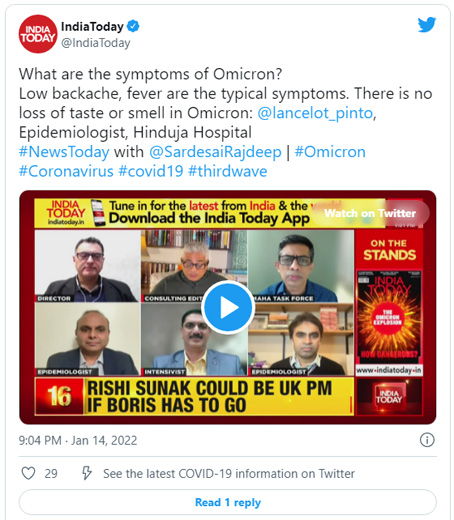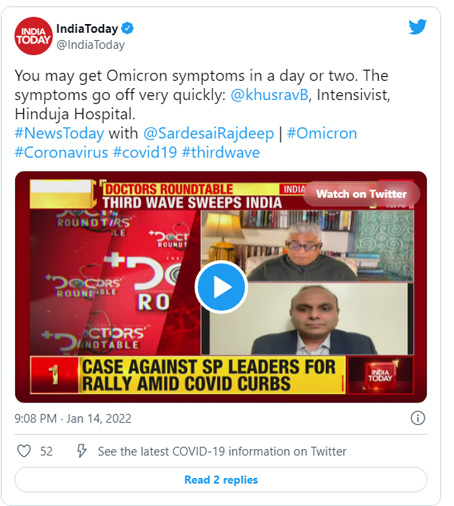|

India has recorded over 2.6 lakh Covid cases.
India Today TV Consulting Editor Rajdeep Sardesai spoke to top health experts, who answered all your Omicron FAQs at Doctors' Roundtable. India recorded 2,64,202 fresh Covid-19 cases in the last 24 hours, 6.7 per cent higher than the tally reported by the Union health ministry on Thursday.
WHAT DID THE DOCTORS SAY
Q) How do I know for sure that I've had Omicron?
I think one of the signature symptoms of Delta used to be the loss of smell or anosmia, as doctors call it. We aren't seeing much of that this time around. I think that's one of the key differentiating factors between Delta and Omicron. Apart from that, most individuals seem to have a lot of body ache with low backache being the most affected. We generally see a little bit of nausea and loose motion in Omicron patients in the first couple of days.

Day 2 and Day 3 are when the fever is around 101 and 101... and Day 4 is when things kind of turn around. This is the typical picture. Day 1 is just body ache and feeling unwell.
Q) Are you saying that an individual can step out after the fifth day?
So, the US CDC says, one can come out of isolation after five days, but it comes with a rider that an individual must follow strict masking in place for another five days. Although the probability is lower, there is still a chance that the individual might transmit on day five or six.
Q) Do symptoms appear faster in Omicron after getting the virus?
Dr Khusrav Bajaj, Intensivist, Hinduja Hospital...
Yes, in Omicron, the symptoms appear much faster and also go off really fast. Once there is an exposure, you might start getting the symptoms in a day or two.

Q) Do we need to test even if the symptoms are mild? Is a RAT good enough?
Dr Khusrav Bajaj adds...
Basically, the question is, do you want to diagnose or do you want to test before leaving the house.
Q) Do asymptomatic patients spread Omicron?
Shashank Joshi, Member, Maharashtra Task Force...
Absolutely. They are the invisible carriers and they definitely spread Omicron. For asymptomatic people, the rules have been tweaked. After seven days, if they are completely asymptomatic, they can double mask and go out to work. Only frontline workers and people, who are on daily wages, have been advised to do that. They, however, are still contagious.
Q) Is Omicron just a cough and cold for most people?
Shashank Joshi, Member, Maharashtra Task Force adds...
We should not dismiss the mild nature of the virus. People who are not in the vulnerable section are also likely to get the virus but will recover with flu-like symptoms.
People like that might only need symptomatic treatment with medicine like paracetamol. That, too, only if the fever is persistent. But people in the high-risk category, like the ones with less immuno response, immuno compromised and comorbidities, could lead to moderate or several disease.
Compared to Delta or its ancestral variants, the likelihood of deterioration is lesser even in vulnerable and vaccinated groups. The only feature of Omicron is immune escape and people who have contracted Covid earlier, may contract this variant.
Q) Is it important for family members of the Covid-affected to isolate themselves?
Dr Rommel Tickoo, Director, Max Healthcare...
If someone has symptoms, the individual will have to be isolated till his/her result comes out. If s/he don't have symptoms, our guidelines now say that we don't have to test them. But I would still advise them to be in quarantine because symptoms might start showing up after four to five days.
Q) Are we already seeing the peak of the third wave or will the cases go up to 4-5 lakhs a day?
Dr Chandrakant Lahariya, epidemiologist...
Currently, the surge is being seen mostly in large and metropolitan cities. We have still not started seeing a surge in medium and smaller towns. Various projections indicate that by the time the major cities start seeing a decline, the smaller towns will see a rise in cases. In the current scenario, we might see two to three short waves. We may not see a very high peak in one go but we might have a sustained high number of cases in the coming three to four weeks.
Courtesy: India Today.
|
